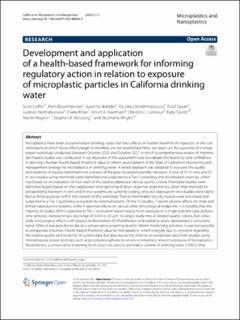| dc.description.abstract | Microplastics have been documented in drinking water, but their effects on human health from ingestion, or the concentrations at which those effects begin to manifest, are not established. Here, we report on the outcome of a virtual expert workshop conducted between October 2020 and October 2021 in which a comprehensive review of mammalian hazard studies was conducted. A key objective of this assessment was to evaluate the feasibility and confidence in deriving a human health-based threshold value to inform development of the State of California’s monitoring and management strategy for microplastics in drinking water. A tiered approach was adopted to evaluate the quality and reliability of studies identified from a review of the peer-reviewed scientific literature. A total of 41 in vitro and 31 in vivo studies using mammals were identified and subjected to a Tier 1 screening and prioritization exercise, which was based on an evaluation of how each of the studies addressed various quality criteria. Prioritized studies were identified largely based on their application and reporting of dose–response relationships. Given that methods for extrapolating between in vitro and in vivo systems are currently lacking, only oral exposure in vivo studies were identified as fit-for-purpose within the context of this workshop. Twelve mammalian toxicity studies were prioritized and subjected to a Tier 2 qualitative evaluation by external experts. Of the 12 studies, 7 report adverse effects on male and female reproductive systems, while 5 reported effects on various other physiological endpoints. It is notable that the majority of studies (83%) subjected to Tier 2 evaluation report results from exposure to a single polymer type (polystyrene spheres), representing a size range of 0.040 to 20 µm. No single study met all desired quality criteria, but collectively toxicological effects with respect to biomarkers of inflammation and oxidative stress represented a consistent trend. While it was possible to derive a conservative screening level to inform monitoring activities, it was not possible to extrapolate a human–health-based threshold value for microplastics, which is largely due to concerns regarding the relative quality and reliability of current data, but also due to the inability to extrapolate data from studies using monodisperse plastic particles, such as polystyrene spheres to an environmentally relevant exposure of microplastics. Nevertheless, a conservative screening level value was used to estimate a volume of drinking water (1000 L) that could be used to support monitoring activities and improve our overall understanding of exposure in California’s drinking water. In order to increase confidence in our ability to derive a human–health-based threshold value in the future, several research recommendations are provided, with an emphasis towards strengthening how toxicity studies should be conducted in the future and an improved understanding of human exposure to microplastics, insights critically important to better inform future risk assessments. | en_US |

